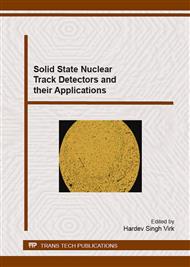[1]
Health Protection Agency, Radon and public health: Report of the independent advisory group on ionising radiation, United Kingdom, (2009).
Google Scholar
[2]
F. Wang and I.C. Ward, Radon entry, migration and reduction in houses with cellars, Building and Environment 37 (2002) 1153-1165.
DOI: 10.1016/s0360-1323(01)00097-x
Google Scholar
[3]
A.R. Denman, N.P. Groves-Kirkby, C.J. Groves-Kirkby, R.G.M. Crockett, P.S. Phillips, and A.C. Woolridge, Health implications of radon distribution in living rooms and bedrooms in U.K. dwellings - A case study in Northamptonshire, Environt Int. 33 (2007).
DOI: 10.1016/j.envint.2007.01.011
Google Scholar
[4]
G. Espinosa and R.B. Gammage. A representative survey of indoor radon in the sixteen regions in Mexico City, Radiat. Prot. Dosim. 103 (2003) 73-76.
DOI: 10.1093/oxfordjournals.rpd.a006119
Google Scholar
[5]
G. Espinosa, J.I. Golzarri, J. Rickards and R.B. Gammage, Distribution of indoor radon levels in Mexico, Radiat. Meas. 31 (1999) 355-358.
DOI: 10.1016/s1350-4487(99)00171-7
Google Scholar
[6]
D. Mazur, M. Janik, J. Loskiewicz, P. Olko and J. Swakon, Measurements of radon concentration in soil gas by CR-39 detectors, Radiat. Meas. 31 (1999) 295-300.
DOI: 10.1016/s1350-4487(99)00135-3
Google Scholar
[7]
N.R. Varley and A.G. Flowers, The Influence of Geology on radon Levels in S.W. England, Radiat. Prot. Dosim. 77 (1998) 171-176.
Google Scholar
[8]
T. Győrfi and I. Csige, Effect of atmospheric pressure variations on the 222Rn activity concentration in the air of a wine cellar, J. Radioanal. Nucl. Chem. 288 (2011) 229-232.
DOI: 10.1007/s10967-010-0947-0
Google Scholar
[9]
V. Urosevic, D. Nikezic, S. Vulovic, A theoretical approach to indoor radon and thoron Distribution, J. Environ. Radioact. 99 (2008) 1829-1833.
DOI: 10.1016/j.jenvrad.2008.07.010
Google Scholar
[10]
W. Zhuo, T. Iida, J. Moriizumi, T. Aoyagi and I. Takahashi, Simulation of the concentrations and distributions of indoor radon and thoron, Radiat. Prot. Dosim. 93 (2001) 357-368.
DOI: 10.1093/oxfordjournals.rpd.a006448
Google Scholar
[11]
G. Espinosa, Trazas Nucleares en Sólidos. Instituto de Física, Universidad Nacional Autónoma de México, ISBN-968-36-4219-5 (1994).
DOI: 10.15415/jnp.2017.51021
Google Scholar
[12]
G. Espinosa, J.I. Golzarri, J. Bogard, I. Gaso, L. Ponciano, M. Mena and N. Segovia, Indoor radon measurements in Mexico City, Radiat Meas. 43 (2013) 431-434.
DOI: 10.1016/j.radmeas.2008.03.039
Google Scholar
[13]
R.B. Gammage and G. Espinosa, Digital Imaging System for Track Measurements, Radiat. Meas. 28 (1997) 835-838.
DOI: 10.1016/s1350-4487(97)00193-5
Google Scholar
[14]
D. Furrer, R. Crameri and W. Burkart, Dynamics of Rn transport from the cellar to the living area in an unheated house, Health Physics. 60 (1991) 939-398.
DOI: 10.1097/00004032-199103000-00009
Google Scholar
[15]
T. Győrfi and P. Raics, Investigation of environmental radioactivity of wine cellars, water course and industrial waste, Applied Radiat. Isot. 69 (2011) 1235-1240.
DOI: 10.1016/j.apradiso.2011.02.024
Google Scholar
[16]
P. Szerbin, I. Vaupotic, I. Csige, I. Kobal, I. Hunyadi, L. Juhász, and E. Baradács, Radioactivity in vine cellars in Hungary and Slovenia, International Congress Series 1276 (2005) 362-364.
DOI: 10.1016/j.ics.2004.12.063
Google Scholar
[17]
F. Wang and I.C. Ward, Multiple radon entry modeling in a house with a cellar, J. Air & Waste Management Assoc. 49 (1999) 682-693.
DOI: 10.1080/10473289.1999.10463840
Google Scholar


